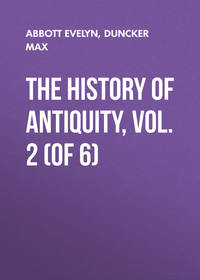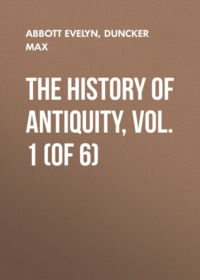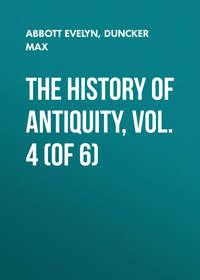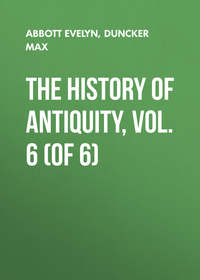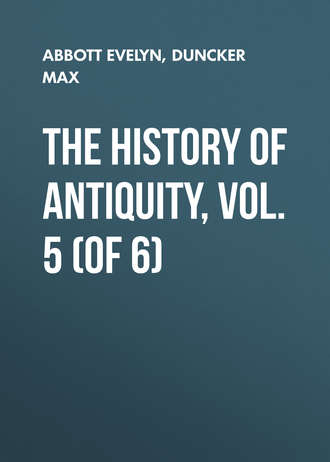 полная версия
полная версияThe History of Antiquity, Vol. 5 (of 6)
CHAPTER IV.
ZARATHRUSTRA AND THE DATE OF THE COMPOSITION OF THE AVESTA. 118
The examination of the difficult questions, whether, from what period, and to what extent, the Avesta was known in Western Iran before the time of Alexander, when the book came into existence, whether its contents have come down uninjured from an ancient period, or whether it underwent alterations in the time of the Parthians and the Sassanids, will be best opened by collecting and testing the accounts which have been preserved in the West about Zarathrustra and his work. Herodotus does not mention him, but Xanthus the Lydian is said to have spoken of him, before the date of Herodotus. Plato describes Zoroaster as the founder of the doctrine of the Magians, and calls him a son of Oromazes.119 With Hermodorus, a pupil of Plato, Zoroaster is a Persian, the first Magian.120 Deinon concludes from the name that he was a worshipper of the stars. Hermippus of Smyrna speaks of him as a Bactrian, and is said to have described him as a pupil of Azonakes (or Agonakes).121 Diodorus informs us that Zoroaster gave out among the Arians that the good spirit had revealed to him the laws which he published.122 Trogus Pompeius relates that Ninus finally carried on war with Zoroaster the king of the Bactrians, who discovered the art of the Magians, and inquired accurately into the primal forces of the world, and the movements of the stars; he was slain by Ninus.123 Pliny observes that Zoroaster, the founder of the doctrine of the Magians, smiled on the day of his birth, and beat his head vigorously as a symbol of his wisdom; for thirty years he lived in the desert on cheese. Plutarch's account is that Zoroaster took no other food or drink all his life but milk, and like Lycurgus and Numa, he associated with the Divine Being.124 Dio Chrysostom tells us that Zoroaster from his love for wisdom and justice lived remote from men in solitude on a mountain, which had been kindled by fire from above, and burned continuously, and when the king approached the mountain with his leading men to offer prayer to the god, Zoroaster came unharmed out of the fire, and bade them offer sacrifice for the god had visited the place. After this Zoroaster did not associate with all men, but only with those who were most adapted to receive the truth and converse with the god, whom the Persians called Magians, i. e. those who have skill to serve the Divine Being.125 Kephalion asserted that Zoroaster the Magian, the king of the Bactrians, fought with Semiramis and was vanquished by her.126 Theon of Alexandria also speaks of the conflict between Semiramis and the Bactrian Zoroaster. Arnobius is aware of the battle of Ninus with Zoroaster and the Bactrians,127 and in Eusebius Zoroaster, the Magian, the king of the Bactrians, fights against Ninus.128 According to the treatise of Eubulus of Athens on Mithras, Porphyrius related that Zoroaster had consecrated a natural cave, in which were flowers and springs, in the neighbouring mountains of Persia, in honour of Mithra, the creator and father of all, and since that time the favour of the god had been sought in a cave.129 Ammianus Marcellinus calls Zoroaster a Bactrian, and tells us that Hystaspes, the father of Darius, spread abroad the doctrine of the Magians.130 Agathias remarks that the Persians of his time asserted that Zoroaster, or Zaradus, as they called him, who gave them their religious doctrine and law, the son of Oromasdes, lived at the time of Hystaspes; but they made the assertion in such a manner that no man knew whether this Hystaspes was the father of Darius or some other of the name. But whatever the date of his life, he changed the earlier forms of worship, and was the discoverer of the doctrine of the Magians.131 Suidas distinguishes between the Perso-Mede Zoroaster, the chief of the Magians, and the astronomer of the same name, an Assyrian, who lived at the time of Ninus.132 In Syncellus, Zoroaster is the first of the eight Median kings, who, according to the statement of Berosus, reigned over Babylonia from 2458 to 2224 B.C.133
These statements do not amount to much. Yet we find the tradition maintained from the pupils of Plato down to Agathias, that Zoroaster founded the doctrine of the Magians; Diodorus, Plutarch, and Dio mention the intercourse of Zoroaster with the good spirit or the deity. Diodorus calls him an Arian, i. e. an inhabitant of Eastern Iran. Hermippus, Trogus Pompeius, Kephalion, Theon, Arnobius, and Eusebius speak of him as a Bactrian, and the king of the Bactrians, and represent him as fighting with Ninus or Semiramis, which is also asserted by Moses of Khorene.134 Hence in the last two centuries B.C. it must have been known in the West that Zoroaster belonged to the East of Iran, and thus he was brought into connection with the most prominent fact known in the history of Bactria, the contest of the Bactrians against Ninus and Semiramis. This story, as we said, comes from the Medo-Persian Epos, and moreover the Epos did not authorise this connection of Ninus and Zoroaster. The opponent of Ninus, who reigned over Bactria, was, according to Diodorus, Oxyartes or Exaortes (p. 20). The fact that Zoroaster was the most important name in the antiquity of Iran among western nations obviously induced Syncellus to put him at the head of the supposed ancient Median dynasty. If Zoroaster, as Pliny and Plutarch think, lived only on milk and cheese, and passed thirty years in the wilderness, these are merely traits taken from the lives of the Brahman ascetics. The story in Dio Chrysostom, that Zoroaster came unharmed from the fire, and the opposite statements of the Chronicle of Alexandria and of Suidas, that he brought down fire from heaven and was consumed by it, or struck by lightning, contain traits which have obviously sprung from the importance which the doctrine of Zoroaster and the Magians ascribe to the worship of fire, and from the division between the fire of lightning and earthly fire, of which we shall speak below. The narrative of Eubulus is founded on the mysteries of Mithra, which came into the West in the first century B.C.135 These mysteries are due to the confusion of the Mithra of the Iranians with the sun-god of the Syrians; the mystæ were consecrated in caves, or in places called caves, and there underwent their probation. As the god of light and the soul Mithra slays in the cave, that is in the world of gloom and matter, the bull which is the symbol of matter, as opposed to light, in its creative power, and conveys the soul, the side of man akin to light, out of the gloom of matter through the heaven of the fixed stars, and then through the heaven of the planets, to the light.136 Ammianus Marcellinus and Agathias have better information about Zoroaster. They are aware that he stands in some relation to Hystaspes. Ammianus, though he expressly describes Zoroaster as a Bactrian, puts Hystaspes the well-known father of Darius, as the supporter of the doctrine of the Magians, in the place of the Vistaçpa of the Avesta, who opens a wide path for the teaching of Zoroaster; Agathias, on the other hand, expresses himself with greater circumspectness; he cannot decide whether the father of Darius or some other Hystaspes is meant.
The result is this: Before the time of Alexander of Macedon, at the latest in the first half of the fourth century B.C., the Greeks were aware that Zoroaster had founded the doctrine of the Magians; in the last centuries B.C. and onwards it was known that he belonged to Bactria and Eastern Iran; but it was not till the fourth century A.D. that he was known to have lived under king Hystaspes; at any rate we have no older evidence on this point.
Much more recent in date, and of far less value, is the information derived from the East, with the exception of the Avesta, on Zarathrustra. It does not go back beyond the period of the Arabian empire over Iran. The Bundehesh, written in this period (p. 65, n. 3), contains a genealogy, which carries Zarathrustra's origin beyond Pourushaçpa and Haechataçpa, from whom, according to the Avesta, he was sprung (p. 38), through twelve generations to Manuschithra (Minocher). In the Avesta, the soul of the pure Manuschithra, the son of Airyu, is invoked;137 it has been observed above that the national genealogy in Iran placed Thraetaona, and not Manu, at the head; Airyu, the son of Thraetaona, was the proper progenitor of the Airyas. With the name Manuschithra, i. e. scion of Manu, who is now the son of Airyu, this table passed back into the old Arian conception of the father Manu (p. 44). In the Avesta, Zarathrustra is connected by his father, the fourth sacrificer of the Haoma, with the old sacrificers; and by deriving his family from Manuschithra the Bundehesh places him in the closest relation to the progenitors of the Airyas. For the rest this book has little to say about the life of Zoroaster. It informs us that the house of Pourushaçpa lay on a hill on the river Daraja, a river which we cannot identify;138 the Bundehesh places it in Airyana Vaeja (Airanvij), in a district which we must place in the high region of the Hindu Kush, on the sources of the Oxus (p. 31, n. 2), though the Bundehesh informs us that "it lay by the side of Atropatene." According to another passage in the book, Airyana Vaeja lay near the garden of Yima and Cashmere. In a third passage the garden of Yima, which we are compelled by unmistakable indications in the Avesta, to seek on the divine mountain, lies in the centre of Iran, under Mount Damkan.139 Atropatene, as a name for the Alpine land in the north-west of Iran (now Aderbeijan), came into use in the time of the Greek empire; at any rate we cannot trace it earlier.140 Athrapaiti means "lord of fire"; athrapata, "one protected by fire"; in the remote mountains of this district the old fire-worship was preserved with peculiar zeal under the Seleucids; from the time of Ardeshir the Sassanids venerated the fire-temple Adar Guçasp (near Takht-i-Soliman), which lay in this region, above all others, and this was the reason why in the time of the Arabs it was thought that Airyana Vaeja must be sought there.141 In any case it is impossible, out of regard to the Bundehesh and even later statements of the Moslem period, to place Zarathrustra in the north-west of Iran in order to represent him as a foreigner, reforming the religion of the north-east, when the Avesta, which distinctly places him in the east and puts him among the sacrificers and heroes of the east and rulers of Bactria, together with the older and more important evidence of the West, is on the opposite side.
The "Book of Zartusht," one of the most recent books of the Parsees (it dates from the thirteenth century of our era), can only tell us of the marvellous preservation of Zarathrustra and the miracles which he wrought. The first miracle recorded in it is the fact that Zoroaster smiled at his birth. But the wicked king Duransarun sought to murder the newly-born child in his cradle. His arm is paralysed, and he cannot strike the blow home. Then the evil spirits steal the child, kindle a great fire in the desert, and throw him into it. But he sleeps peacefully in the fire, and his mother recovers him without injury. A herd of cattle are about to trample him on a narrow path, when the largest one stands over and protects him, till the herd have passed by. In a similar manner he is preserved when a pair of wild horses are driven over him. Even the wolves will not eat him. When he has reached his thirtieth year these trials are over, and Zarathrustra emigrates with his followers. On reaching Iran the good spirit Vohu mano appeared and conducted him to Auramazda. He had to pass over a fiery mountain, but the fire did not singe a hair; molten metal was poured on his breast, and he felt it not; his entrails were removed and then replaced without injury to him. Auramazda gave him the Avesta and commanded him to go to king Vistaçpa (now Kai Gushtaçp) to Balkh, and proclaim it to him. In Balkh Zoroaster overcame the sages of the king in argument, but they maligned him before their master as a wizard, and he was put in prison. Then the feet of the king's horse were drawn up into its belly, and the king bade Zarathrustra heal his horse. He required the king to believe in him and his doctrine; and when the king had acknowledged the new faith, one of the horse's feet was restored to it. Zarathrustra further demanded that Vistaçpa's son Çpentodata (Isfendyar) should consecrate himself to the defence of the new faith, that the king's consort should adopt the law, and those who maligned him should be punished. When these three requests had been complied with, the horse recovered all its four feet. After this Vistaçpa did nothing without the advice of Zarathrustra, and built fire-altars and fire-temples. And Zarathrustra showed the king the place he would one day occupy in heaven, and made Çpentodata invulnerable.142
Hence from the Bundehesh we obtain no more than the genealogical tree of Zarathrustra, which though characteristic for the place allotted to him, is without historical value; and from the Zartusht Nameh, Sharastani, and Mirkhond, which repeat some miracles more or less similar to those quoted, we gather nothing beyond certain traits: the smiling at birth, the fiery mountain, the preservation of Zarathrustra in the fire, which Pliny and Dio Chrysostom had already made known to us, and which belong to the ancient tradition of Iran. In the miracles which take place by means of oxen and horses, we can merely recognise the ancient and close relation of the Arians in Iran to these animals, a relation which has already been remarked (p. 46). We might perhaps add that Firdusi represents Zarathrustra, whom he puts beside Vistaçpa, as having been killed at a fire in Balkh when the city was captured by Turanians. The intercourse of Zarathrustra with Auramazda was known to Western writers, as we saw, at a far earlier date.
If we can hardly glean anything worth notice from these accounts about Zarathrustra's life and work, we may perhaps gain some information about his date. The evidence of Ammianus Marcellinus and Agathias, when they represent him as a contemporary of Hystaspes, in whom we recognise Vistaçpa of Bactria, carries us no further than the Avesta, which places him in the closest relation to this prince (p. 38), because his date is equally uncertain. Trogus Pompeius, Kephalion, Theon, and Eusebius make Zarathrustra an opponent and therefore a contemporary of Ninus and Semiramis. But as neither Semiramis nor Ninus ruled over Asshur, and they are to be regarded as the personification of the rise of the power and dominion of that country (II. 23), we must substitute for this king and queen the ruler or rulers of Asshur of whom it is certain that their campaigns reached the east of Iran. We found that so far as we can at present judge from the monuments it was only Shalmanesar II. who received tribute from the Eastern lands, and that the armies of Tiglath Pilesar II. trod the soil of Arachosia (p. 19). If we could assume that the contests of Ninus and Semiramis have taken the place of the achievements of these rulers in the East of Iran, the date of Vistaçpa and Zarathrustra would have to be placed between 860 and 740 B.C. But this supposition is really without any basis.
The more ancient statements of the Greeks carry us much further back than the reasoning of Trogus Pompeius and his successors. If we set Pliny aside, who asserts "that the kind of Magism established by Zoroaster was many years older than that taught by Moses," Hermippus of Smyrna puts Zoroaster 5000 years before the Trojan war. Even before Hermippus, Theopompus of Chios, and Hermodorus, the pupil of Plato, had ascribed the same date to him. Eudoxus of Cnidus, the contemporary of Plato, placed him still higher; he thought that Zoroaster lived 6000 years before the death of Plato. According to Pliny, Aristotle ascribed to him the same antiquity, and, as we learn from Diogenes Laertius, maintained that the Magians were older than the Egyptians. And even in the fifth century B.C., Xanthus the Lydian is said to have written that from the time when Zoroaster lived to the march of Xerxes against Hellas a period of 6000 years had elapsed.143
Through these statements there runs, beyond all doubt, a system, the knowledge of which began in the fifth century B.C. among the Greeks and continued beyond the time of Alexander. Whether we take 5000 years before the Trojan war, or 6000 years before Plato's death, we are equally brought back into the seventh millennium B.C. If the later statements of the West, which make Zoroaster a contemporary of Ninus and Semiramis, are the results of combining the most prominent name in Bactria with the conquest of Bactria by the founder of the Assyrian power, as related in the Medo-Persian Epos, the fixing of Zoroaster's date so many thousand years previously must have been taken by the Greeks from the Persians. In these dates we seem to be dealing with certain cyclic periods. We learn from Theopompus of Chios, that according to the doctrine of the Magians, one of the two gods Oromazdes and Areimanius would reign and the other be subject for 3000 years; for another 3000 years they would be in conflict, and one destroy the works of the other, until at length Areimanius would succumb and men become happy.144 From this we may with certainty conclude that periods of 3000 years were in use among the priests of Iran to denote certain spaces of time, and that these cycles form the base of the statements of the older Greeks, if we can prove the use of such periods in the Avesta or in the books of the Parsees.
In the fragments of the Avesta which have come down to us we find invocations addressed to the "time without beginning," "the time that rules the long periods."145 But the fact that Yima's reign is fixed at 1000 years shows that the priests of Iran reckoned by long periods, and other expressions in the Avesta (p. 33) prove that triple multiplications were in use,146 which agrees with the periods given by Theopompus. If, therefore, the Greeks of the fifth and fourth century B.C. relate that Zarathrustra lived about 6000 years before their time, a system must by that time have been current among the priests of Iran in which two cycles of 3000 years were supposed to have elapsed since the time of the prophet, and the third cycle had commenced. A book of the Parsees, the Mainyo-i-Khard, which appears to have been written towards the close of the empire of the Sassanids,147 tells us that Angromainyu made a compact with Auramazda for 9000 winters, and when these winters were past, Angromainyu would be destroyed, and the creation and all creatures would be as Auramazda had made them.148 The Bundehesh also speaks of a similar compact, but divides the years in a different manner. All time consists of 12,000 years. In the first 3000 Auramazda reigned alone with the creatures which he had created in an invisible manner; for the first 3000 of the next 9000 everything went according to the will of Auramazda; for the second 3000 the will of Auramazda was crossed by that of Angromainyu, but for the last 3000 Angromainyu will be powerless. The Bundehesh goes into yet further detail in these matters: in the first 3000 years the heavenly creation was secure from attack; in the next 3000 Gayo maretan and the ox, i. e. the first man and the first bull, came into existence. After these 6000 years the enemy arose and slew the first man and the first bull. The reign of Yima is placed by the Bundehesh in the first millennium of the new period, but this reign extends only to 716 years, the first 284 years of the thousand being filled with creatures prior to Yima. The second millennium of the period is occupied with the reign of Thraetaona, Manuschithra, Kava Kavata, Uça, Huçrava, and Aurvataçpa, and the early part of the reign of Kava Vistaçpa, whose thirtieth year coincides with the end of the second millennium.149 At the beginning of the third millennium, i. e. a thousand years after the death of Yima, Zarathrustra appears; and the period of more successful opposition to the evil spirits begins. According to the more ancient conception, which may still be plainly traced in the Avesta, the world began with the happy age of Yima; it is owing to later views formed within priestly circles that earlier creatures such as the first man and first bull are placed before this period; but it will be shown below that these views existed when the Avesta was written down. A later book of the Parsees, the Sad-der-Bundehesh, puts the period of the conflict between the good and evil deity at 6000 years, and places Zarathrustra exactly in the middle of it; he was created 3000 years after the period of Gayo maretan, and 3000 years before his own resurrection.150 Hence it is clear that the formation of these cycles rose among the priests of Iran from the necessity of limiting the period of the old and new law, and of conflict between the good and evil spirits, and the desire to fix the date of the more successful repulse of evil which came in with Zarathrustra. The abbreviation of the period of Yima shows us that the cycles in the Bundehesh do not throughout agree with those of the Avesta. But it is sufficient to establish the fact that periods of 3000 years were in use, and that Zarathrustra appeared at the beginning of a new millennium, in order to understand that the Persians could speak to the Greeks of millenniums in this sense, and of one or two cycles which had elapsed since Zarathrustra's time.
The idea and tendency of such a scheme for the history of the world are easily understood: these periods of 3000 years, which can be increased or diminished without alteration of the sense, have only a dogmatic value. We cannot obtain from them any chronological date for the appearance of Zarathrustra, nor can we obtain such a date by the attempt to go back from the chronological statements in recent Parsee works to the older periods. We may leave unnoticed the assertion in the book of Arda Viraf that the true faith had existed in purity for 300 years down to the time that Alexander came into Iran (p. 50), which would thus bring Zarathrustra into the seventh century B.C. The Bundehesh allows 460 years for the reigns of the Sassanids, 246 for the Askanids, i. e. the Arsacids, 16 for Alexander, before whom come Darai the son of Darai with 14 years, Darai Chirazatan with 12, Huma (a queen) with 30, Vohumano with 112, and Vistaçpa with 90, – all subsequent to the appearance of Zarathrustra.151 According to this, 996 years elapsed between Zarathrustra and the fall of the Sassanids, and he would thus, if we reckon from the battle of Nahavend (640 A.D.), be placed in the year 356 B.C., in the reign of Artaxerxes Ochus. But even if we alter the incorrect items in the text of the Bundehesh in accordance with our better knowledge, we do not arrive at any result which is even apparently certain. The dominion of the Sassanids, down to the date of the battle, did not last 460 but only 414 years; on the other hand, the Arsacids reigned for 476 years, not for 264.152 The empire of Alexander, if we add the reigns of the Seleucidæ to his own, occupied 80 years instead of 14, and if in the place of the 26 years of the two Darais of the Bundehesh, who represent the kingdom of the ancient Achæmenids, we put the old Persian kingdom with 229 years, and add to these items the numbers given in the Bundehesh for Huma, Vohumano, and Vistaçpa, after the appearance of Zarathrustra, which amount to 232 years, Zarathrustra would have commenced his work 1431 years before the battle of Nahavend, i. e. in the year 791 B.C. But who can guarantee that Cyrus, the Persian, overthrew the empire of the Medes in the year when Huma, the supposed daughter of Vohumano, died; or that Huma reigned for 30 years? How could Vohumano, the grandson of Vistaçpa, and son of Çpentodata (p. 38), have reigned 112 years, and Vistaçpa himself 90 years after the appearance of Zarathrustra? Huma is not merely a doubtful person, she is altogether fictitious. She is said to have been the mother of Darai Chirazatan, i. e. Darius I., and to have been called Shamirain, i. e. Semiramis, but her brother was the first Sassan, the ancestor of the Sassanids. As the later Arabs and Persians, including Firdousi, are no better informed,153 we see clearly that the remembrance of the Achæmenids had almost entirely died out at the time when these writings were composed; only the name of Darius remained, and an attempt was made to connect this name with Vistaçpa by two fictitious names, Vohumano, i. e. the good spirit, and Huma. Besides Vistaçpa's son Çpentodata (Isfendyar) and Hutaoça, the wife of Vistaçpa, the Avesta mentions a woman, "the pure Huma,"154 out of whom this queen must have been formed. It is clear that the tradition of the East, like the Avesta, broke off in the generation after Vistaçpa, and that in the Arabian period only the names Darai and Iskander could be placed between Vistaçpa and the Arsacids.




